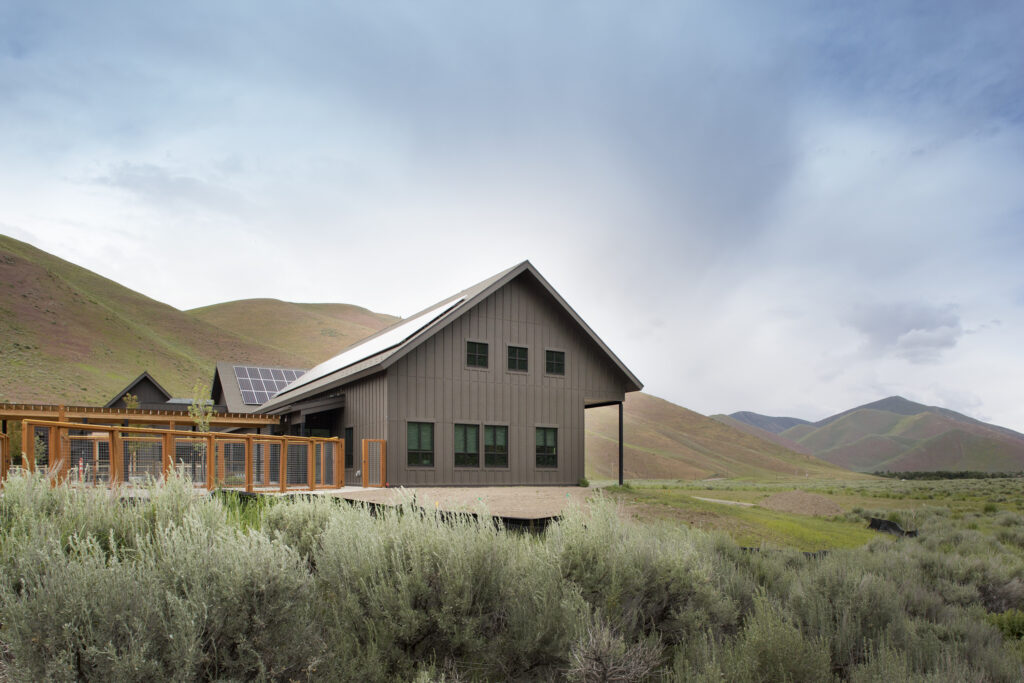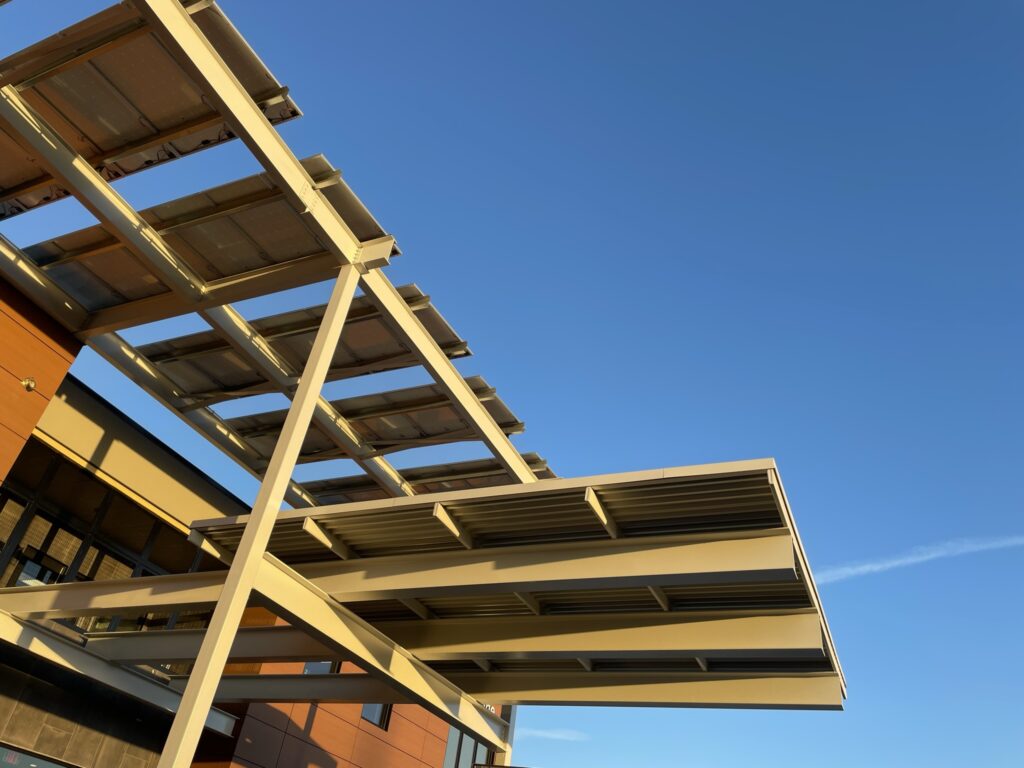
As the cost of nearly everything has increased over the past few years, we veterinary architects continue to consider what this will mean for average equine veterinarians, particularly those who have or are planning facilities. Even the simplest haul-in clinic costs much more to build and operate than before. One idea we have been exploring to reduce ongoing operational costs for hospitals and clinics is the effective use of solar power. This does take an initial investment from the veterinary practice, but it has good return on investment.
The newest California building codes already mandate some integration of solar power. But even if you live in a state without a mandate, you might want to save on ongoing electricity costs over the building’s life span or take advantage of federal, state, or local utility incentive programs by incorporating solar into your veterinary practice.
Even if you cannot afford solar power now, designing for the technology can be a good strategy, because it is only going to become more affordable and reasonable for the average building owner over time.
Definitions and Limitations
If your equine facility is very small and limited in its use, such as a haul-in structure in a sunny, arid climate, it is possible to be off grid completely with electrical systems and to include solar power for all building power and lighting. However, most equine hospitals require much larger power usage for code-compliant ventilation, air conditioning, and running medical equipment. For example, it is not (currently) reasonable or affordable to power CT or MRI machines and other large imaging equipment with solar sources.
Therefore, as we explore the topic of solar, we will discuss the most applicable technologies, regardless of your building’s size or complexity. These include solar power for heating water as well as for powering building systems, otherwise known as photovoltaics. The most useful system to power via solar in a veterinary facility is the lighting.
Incentives and Loan Programs
Equine clinics and hospitals are commercial buildings. Currently, there is a glut of incentive programs for commercial building owners, both at state and federal levels, to install solar technologies. The many programs can be overwhelming to understand, so we suggest you begin your research by talking with a well-regarded commercial solar power design and installation company. They will know the details of these incentives and can be a good source of knowledge as you price and consider solar design. Your design team might also have knowledge in this area, so use your information sources wisely to protect your time.
To provide a rough overview of federal incentives, they include but are not limited to:
- 179D tax deductions for commercial building owners that reduce energy usage by 25%.
- Loan programs via the Department of Energy State Energy Program (DOE SEP). These could help you fund solar power installation and might even pay for it, partially or fully, via grants, for which small businesses can qualify.
- A 30% solar incentive tax credit offered through 2032.
In addition, several states have very good incentive programs. For example, if your practice is in Arizona, it pays to consider solar technology, as the state leads the way in solar incentives. Finally, many utility companies are investing in green technologies and are mandated to do so. Therefore, utilities often provide incentive programs for solar power.
When Is Solar the Right Choice for Your Veterinary Practice?
Solar panels will be most effective if your equine clinic has the following characteristics:
- Located in a sunny part of the country, such as the Mountain West, the Southwest, Texas, and Hawaii. Other locations can also be well-suited, but solar panels will be less effective in typically overcast locations such as the Northeast. That said, solar technologies work in all locations, just at less efficiency in cloudy locations than in sunny ones.
- Oriented and designed correctly for solar installations. If you can plan for a large south-facing roof surface, that is ideal. Other orientations might work as well, but if you have a new building and are planning to use solar panels, it is best to integrate them into the design from the beginning. Solar panels like to occupy large, contiguous areas rather than small, chopped-up ones. For example, the south-facing roof of a large barn could be perfect. Ensure the building’s structural system anticipates the addition of solar panels. While the panels are not particularly heavy, your structural engineer must still include them in his or her calculations.
- Covered parking to protect vehicles in extremely hot climates such as in Arizona, Florida, or Texas, for example. Parking canopies are some of the most commonly used structures for the integration of solar power.
- High energy costs. Those same hot climates are perfect targets for solar installations, as building owners will have high monthly energy costs for air conditioning.
Using Solar Panels Effectively in Your Veterinary Practice

Solar water heating is an easy decision. It does not require much panel area to heat hot water for a building, especially because you can store that water in a tank. It is still a good idea to have a backup conventional water heater, but you can eliminate at least 60% of water heating energy using a solar system (Whole Building Design Guideline). Solar hot water is a good choice for use at equine hospitals, which have regular hot water needs throughout the day.
Photovoltaic arrays (solar panels) can provide power to your building, and the simplest way to utilize this technology is for the building lighting system. Lighting accounts for around 17% of the energy usage in a modern commercial building (Energy.gov).
To integrate solar panels—for hot water, lighting, or other power—allocate areas for the panels early in the design process. The options are 1) roof-mounted, 2) ground-mounted, or 3) mounted on separate structures such as covered parking canopies. The roof-mounted option is usually the most practical, as it does not take up additional space. Roof-mounted solar panels can be on top of roofing systems to reduce or eliminate roof penetrations, or they can be integrated completely with a building roofing system. For equine hospitals, we would choose the simplest and most cost-effective system, which is to place panels on top of roofing systems (see photo on page ?).
A photovoltaic array delivers electricity via direct current. It then goes through an inverter at the building electrical room, where it gets converted to alternating current and delivered to lighting and/or receptacle electrical panels. We recommend placing a conduit from where the solar array will be located to the inverter, even if you cannot afford the initial installation of the solar panels. That way, the building will be ready for solar when you are.
Intermittency Mitigation
Solar panels do not work when the sun is not shining. For example, they do not work at night. However, energy can be stored using battery systems, thereby mitigating the intermittency of the solar power source. Alternatively, electricity from the grid can power systems when the solar source is not being used.
Life Span and Results for Solar in Your Veterinary Practice
A good solar installation will last at least 25 years, with very little maintenance. This makes solar power a satisfying investment. Without incentives, solar installations typically provide an internal rate of return (IRR) of 10% per year, with a payback period of seven to 10 years. With incentives, this payback period drops significantly. The incentives have never been better than they are now, and the time is right to see if solar can reduce your ongoing energy costs and reliance on commercial utilities for your equine practice.








